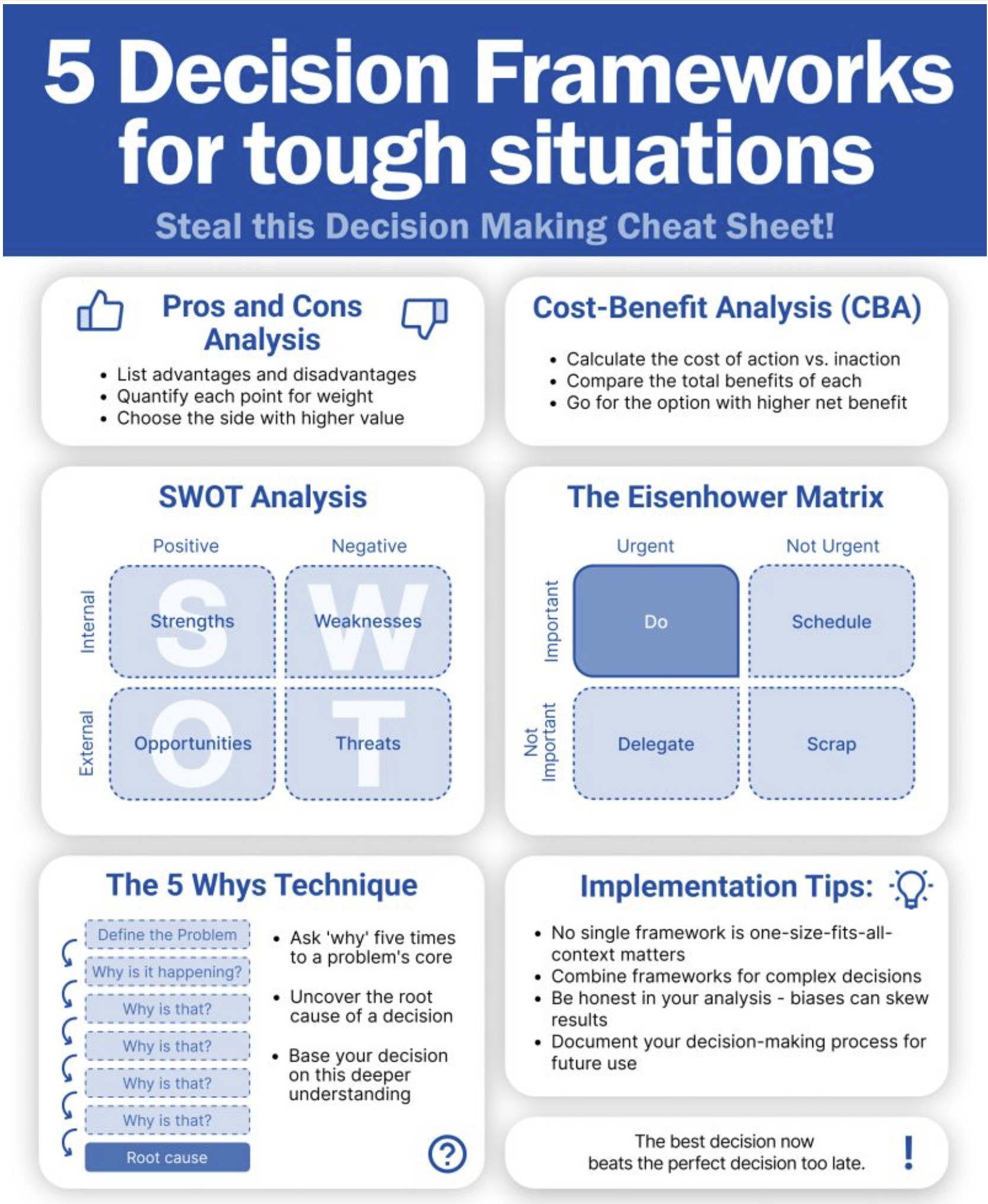应对严峻形势的五个决策框架
5-decision-frameworks-for-tough-situations
应对严峻形势的5个决策框架
决策瘫痪?难以抉择?怎么办?无论你是在指导一家初创企业,还是在辅导一个团队,每个领导者都会面临艰难的抉择。摒弃猜测,制定战略。这就是你的决策框架大礼包:
1️⃣利弊分析
- 权衡利弊
- 量化每个因素
- 选择最有利的一方2️⃣ SWOT 分析
- 优势、劣势、机会、威胁
- 确定哪些需要利用,哪些需要应对3️⃣ 艾森豪威尔矩阵
- 紧急与重要
- 确定优先次序、委派、安排或取消4️⃣成本效益分析
- 决策的经济学
- 收益大于成本?去做吧!
- 效率 > 努力5️⃣"5个为什么 "技巧
- 深入探究问题
- 找出根本原因
- 提出 5 个 "为什么",得到一个明确的答案
➡ + 实施技巧!
成为决策的主导者,大胆领导。
偷来这份小抄,让你的思路更加清晰。
一.利弊分析
说明:
-列出您所面临决策的所有潜在利弊。
-根据每个因素的重要性为其分配权重。
-将总权重较大的一方视为更有利的选择。
反思问题:
-这个决定有哪些潜在的好处?
-潜在的缺点是什么?
-就我们的目标而言,每个利弊因素的重要性如何?
二.SWOT 分析
说明:
-确定与情况相关的优势、劣势、机会和威胁。
-分析如何利用优势和机遇。
-制定策略,解决弱点,减少威胁。
自省问题:
-在这种情况下,我们可以利用哪些优势?
-我们需要克服哪些弱点?
-我们能否抓住机遇?
-我们应该为哪些威胁做好准备?
三.艾森豪威尔矩阵
说明:
-根据紧迫性和重要性对任务或决策进行分类。
-优先处理既紧急又重要的任务。
-下放紧急但不重要的任务。
-安排重要但不紧急的任务。
-取消既不紧急也不重要的任务。
自省问题:
-哪些任务需要立即关注并采取行动?
-哪些工作可以委托给他人?
-哪些应该安排在以后?
-哪些可以从清单中删除?
四.成本效益分析 (CBA)
说明:
-计算与决策相关的成本和收益。
-评估收益是否大于成本。
-选择净收益较高的方案,确保效率高于努力。
自省问题:
-该决策的有形和无形成本是多少?
-短期和长期效益是什么?
-收益的经济价值是否能证明所涉及的成本是合理的?
五.问5个为什么的技巧
说明:
-从最初的问题开始,连问 5 个 "为什么?",找出问题的根本原因。
-用这些答案来指导你的决策过程。
自省问题
-为什么当前情况会成为问题?
-为什么会存在这个问题?-我们能否找出一种模式或根本原因?
-如何通过解决根本原因来防止未来的问题?
实施技巧:
请记住,没有一个框架适合所有情况。必要时结合框架。
注意可能影响分析的偏见。
记录决策过程,以便参考和持续改进。
通过利用这些框架和思考这些问题,您可以以结构化和战略性的思维方式进行决策。这将有助于最大限度地减少不确定性,使您能够做出符合目标的明智选择。
 5 Decision Frameworks for Tough Situations
5 Decision Frameworks for Tough Situations
Decision paralysis? Not anymore.
Whether you're steering a startup or coaching a team, every leader faces tough calls.
Ditch the guesswork and get strategic.
Here's your power pack of decision-making frameworks:
1️⃣ Pros and Cons Analysis
• Weigh the good and the bad
• Quantify each factor
• Opt for the side tipping the scales2️⃣ SWOT Analysis
• Strengths, Weaknesses, Opportunities, Threats
• Identify which to leverage and which to counter3️⃣ Eisenhower Matrix
• Urgent vs. Important
• Prioritize, delegate, schedule, or scrap4️⃣ Cost-Benefit Analysis
• The economics of decision-making
• Benefit outweighs cost? Go for it!
• Efficiency > effort5️⃣ The 5 Whys Technique
• Dive deep into the problem
• Identify the root cause
• Ask 5 'whys' for one clear answer
➡ + implementation tips!
Be the boss of your decisions and lead with guts.
Steal this cheat sheet for maximum clarity.
Pros and Cons Analysis
Instructions:
List down all the potential advantages and disadvantages of the decision you're facing.
Assign a weight to each factor based on its significance.
Consider the side with the greater total weight as the more favorable option.
Questions:
What are the potential benefits of this decision?
What are the potential drawbacks?
How significant is each pro and con in the context of our goals?
SWOT Analysis
Instructions:
Identify the strengths, weaknesses, opportunities, and threats related to the situation.
Analyze how you can utilize your strengths and opportunities.
Develop strategies to address your weaknesses and mitigate threats.
Questions:
What strengths can we leverage in this situation?
What weaknesses do we need to overcome?
Are there opportunities we can seize?
What threats should we be prepared for?
Eisenhower Matrix
Instructions:
Categorize tasks or decisions based on urgency and importance.
Prioritize tasks that are both urgent and important.
Delegate tasks that are urgent but not important.
Schedule tasks that are important but not urgent.
Eliminate tasks that are neither urgent nor important.
Questions:
Which tasks need immediate attention and action?
What can we delegate to others?
What should we schedule for later?
What can we remove from our list?
Cost-Benefit Analysis (CBA)
Instructions:
Calculate the costs and benefits associated with the decision.
Assess whether the benefits outweigh the costs.
Choose the option with the higher net benefit, ensuring efficiency over effort.
Questions:
What are the tangible and intangible costs of this decision?
What are the short-term and long-term benefits?
Does the economic value of the benefits justify the costs involved?
The 5 Whys Technique
Instructions:
Start with the initial problem and ask "Why?" five times to drill down to the root cause.
Use the answers to inform your decision-making process.
Questions:
Why is the current situation a problem?
Why does this problem exist?
Can we identify a pattern or underlying cause?
How can addressing this root cause prevent future issues?
Implementation Tips:
Remember that no single framework fits every situation. Combine frameworks when necessary.
Be aware of biases that might skew your analysis.
Document the decision-making process for reference and continuous improvement.
By utilizing these frameworks and reflecting on these questions, you can approach decision-making with a structured and strategic mindset. This will help to minimize uncertainty and enable you to make informed choices that are aligned with your goals.



 5 Decision Frameworks for Tough Situations
5 Decision Frameworks for Tough Situations